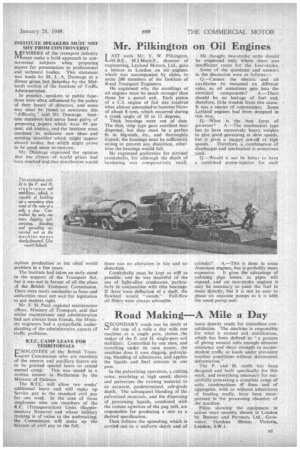Mr. Pilkington on Oil Engines
Page 9

If you've noticed an error in this article please click here to report it so we can fix it.
T AST week Mr. V. W. Pilkington, " M B.E M.I.Mech.E., director of engineering, Leyland Motors, Ltd., gave a lecture in London .on oil engines, which was accompanied by slides, to some 200 members of the Institute of Road Transport Engineers.
He explained why the scantlings of oil engines must be much stronger than those for a petrol unit. Each piston of a C.I. engine of fair size received what almost amounted to hammer blows of about 8 tons, which occurred during a crank angle of 10 to 12 degrees.
Thick bearings were out of date. The thin, strip type gave excellent heat dispersal, but they must be a perfect fit in big-ends, etc., and thoroughly. nipped; the housings must be sufficiently strong to prevent any distortion, otherwise the bearings would fail.
He expressed preference for nitrided crankshafts, for although the depth of hardening was comparatively small, there was no alteration in size and no distortiOn. — Crankshafts must be kept as stiff as possible, and he was doubtful of the use of light-alloy' crankcases, 'particularly in conjunction with thin bearings. If there were deflection of a shaft, the flywheel would "swash." Full-flow Oil filters were always advisable. -He thought two-stroke units should be employed only wherethere was insufficient room for the four-stroke.
Some of the questions and answers in the discussion were as follows: .Q.—Cannot the electricand oil auxiliaries be mounted on different sides, as oil sometimes gets into the electrical components? A.—There should be no leakage of fuel and. therefore, little trouble from this cause. It was a matter of convenience. Some Leyland engines had been designed in this way.
Q.—What is the best form of governor? A.—The mechanical type has to have excessively heavy weights to give good governing at slow speeds, but it gives a snappy cut-off at high speeds. Therefore, a combination of diaphragm and mechanical is sometimes used.
Q.----Would it .not be better to have a combined pump-injector for each cylinder? A.—This is done in some American engines, but is probably more expensive. It gives the advantage of reducing pipe losses, as pipes will expand, and on two-stroke engines it may be necessary to push the fuel in more directly, but it is not so easy to phase six separate pumps as it is with the usual pump unit.




























